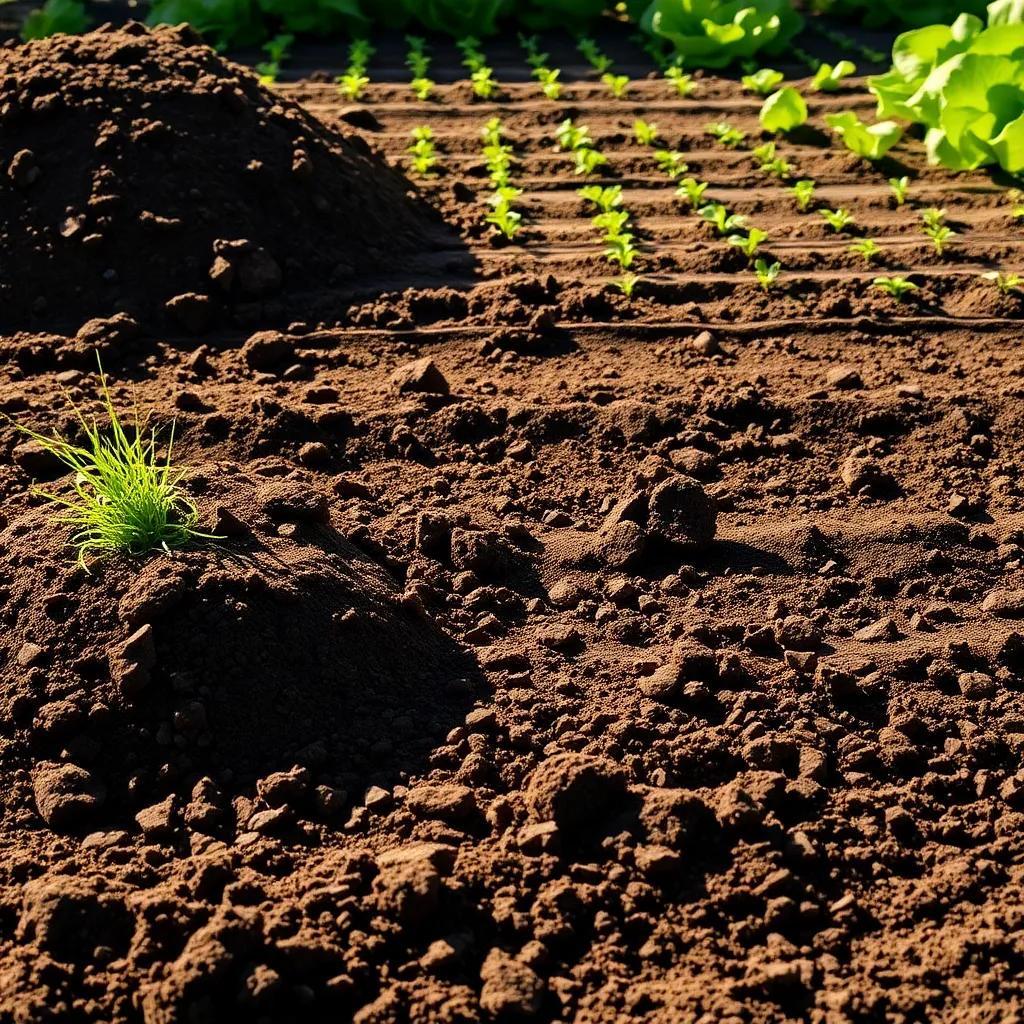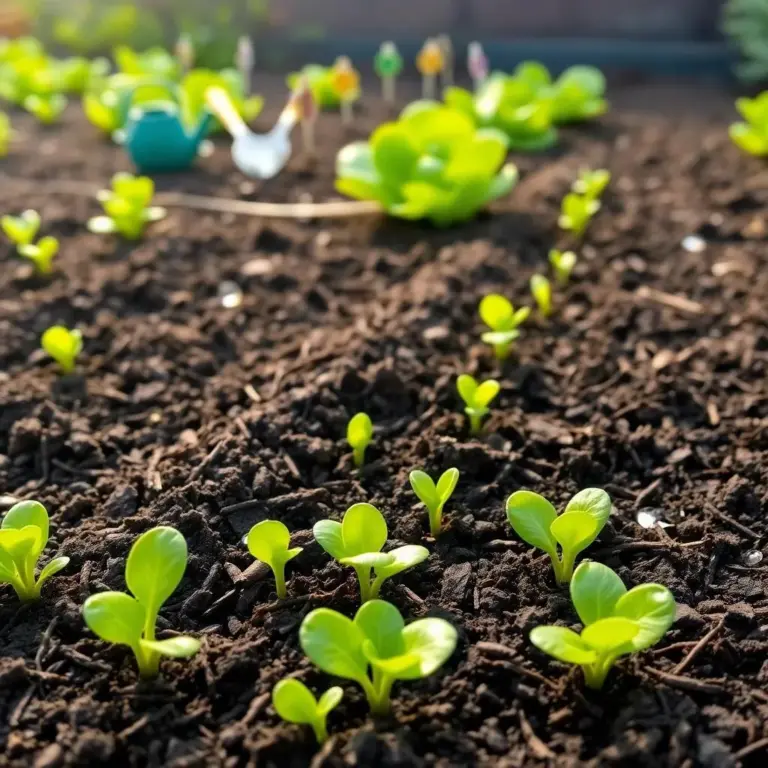Growing my own lettuce is like magic! From tiny seeds to crunchy leaves, it’s a fun adventure filled with excitement. Join me as I share my secrets on how to prepare the soil, plant those little gems, and care for them so they thrive in your garden. Let’s get our hands dirty and make some delicious salads together!
Preparing the Soil for Lettuce Seeds
Getting the soil ready for my lettuce seeds feels like setting the stage for a grand performance! Healthy lettuce starts with well-prepared soil. So, let’s get our garden beds in tip-top shape! Here’s how I do it:
- Choose the Right Spot: Lettuce loves sunshine, so I pick a spot that gets at least 6 hours of sunlight a day. Think of it as finding the perfect sunny spot for a picnic!
- Clear the Area: I make sure to remove any weeds, rocks, or old plant debris. We don’t want any unwanted guests crashing our lettuce party!
- Loosen the Soil: Using a garden fork or shovel, I break up the compacted soil. This allows the roots to grow freely, plus it leaves the perfect cozy home for my seeds. If the soil is too hard, the seeds may struggle to sprout. Nobody wants a shy lettuce plant!
- Add Organic Matter: Mixing in compost or well-rotted manure transforms my soil into a nutrient-rich haven. Organic matter helps with water retention and provides essential nutrients! Who doesn’t want happy lettuce, right?
- Check the pH: I always test the soil pH! Lettuce prefers a pH between 6.0 and 7.0. If it’s too acidic, I add a bit of lime, and if it’s too alkaline, a little sulfur can help. It’s like giving my soil a little spa treatment!
- Level It Out: Finally, I smooth out the soil with a rake. An even surface means my seeds will have a fair chance to grow without any bumps in the road!
Getting the soil ready might take some effort, but it’s totally worth it. Think of it as giving my lettuce a great start in life. Now, I can’t wait to plant those seeds!
Planting Techniques for Successful Germination
Alright, the soil is prepped, and it’s time for the fun part—planting the seeds! I always get a little buzz of excitement when I think about how these tiny seeds will grow into delicious lettuce. Here’s how I like to plant my lettuce seeds for the best results:
- Timing is Key: First things first, I check the season! Lettuce thrives in cooler weather, so I usually plant in early spring or fall. Trust me; no one wants to deal with wilting lettuce in the hot sun!
- Spacing It Right: Depending on the type of lettuce I’m growing, I make sure to follow the spacing guidelines. Typically, I plant them 6 to 12 inches apart. Giving them personal space helps them grow big and strong!
- Depth Matters: I like to plant the seeds about 1/4 inch deep. Not too deep, not too shallow—just right! After placing the seeds, I gently press the soil over them, making sure they have good contact with the soil.
- Row or Broadcast Planting: I can either make furrows for row planting or sprinkle them across the soil for a more natural look (that’s called broadcast planting). Both methods work—so it’s all about what I prefer!
- Watering After Planting: Once my seeds are in the ground, I give the area a gentle watering. I avoid a heavy downpour to keep the seeds in place. After all, we want them to settle in nicely!
- Mulch for Success: Adding a thin layer of organic mulch after they sprout helps keep the soil moist and protects the little seedlings from pesky weeds. It’s like giving them a cozy blanket!
Watching those seeds sprout is one of the most rewarding things! With the right planting techniques, my lettuce will thrive, and soon enough, I’ll be enjoying fresh, crunchy salads from my garden. What a delight!

Watering Guidelines for Healthy Lettuce Growth
After planting those tiny lettuce seeds, one of the most exciting parts begins—watering! Proper watering can make or break our lettuce plants, so here’s how I keep them happy and hydrated.
- Consistency is Key: Lettuce loves moisture like I love my morning coffee! I aim to water my plants every 2 to 3 days. But I always check the top inch of the soil first. If it feels dry, it’s time to water. Keeping it consistent helps my lettuce grow strong and healthy!
- How to Water: I use a gentle watering can or a soaker hose. A fine mist or light spray is best for those delicate little leaves. Overhead watering can splash dirt onto the leaves, and nobody likes a dirty salad!
- Deep Watering: I give my lettuce a good deep watering, making sure the water reaches the root zone. This encourages the roots to grow deep into the soil, helping them resist drought better later on. Plus, deep roots mean happier plants!
- Watch the Weather: During hot days, my lettuce might need more frequent watering. If it’s super dry, I might need to water daily! A little extra attention goes a long way.
- Mulch Matters: After my seeds sprout, I love adding a thin layer of organic mulch around the plants. It helps keep the soil moist, reduces weeds, and keeps the temperature just right.
By following these watering guidelines, I can keep my lettuce thriving! Nothing is as satisfying as seeing my plants flourish and knowing I’m giving them the TLC they need.
Nutrient Management for Optimal Lettuce Yield
Let’s talk about feeding our lovely lettuce plants! Just like I need a balanced meal, my lettuce needs the right nutrients to grow strong and tasty. Here’s how I manage nutrients for a fantastic harvest:
- Soil Testing: Before I add anything to my soil, I always conduct a soil test. It’s like getting a health check-up for my garden! This test tells me the nutrient levels and pH, helping me decide what my soil needs.
- Organic Matter: Adding compost or well-rotted manure before planting is a fantastic way to enrich the soil. It improves soil structure and increases its nutrient content. Plus, it helps retain moisture—what’s not to love?
- Fertilizers: I typically use a slow-release organic fertilizer before planting. It slowly feeds the plants over time, which means less worry for me! I just follow the manufacturer’s instructions to avoid giving them too much.
- Side-Dressing: As my lettuce grows, I like to sprinkle a bit of balanced granular fertilizer around the base of each plant. This is called side-dressing! It gives my plants a nutrient boost when they need it most. Just make sure it doesn’t touch the leaves!
- Nitrogen Needs: Lettuce loves nitrogen! It helps produce those delicious leafy greens. I start with a nitrogen-rich fertilizer early on, then switch to a balanced or lower nitrogen fertilizer as they mature. Too much nitrogen can lead to lush growth but smaller heads.
By managing nutrients well, I can enjoy a plentiful harvest of fresh, crunchy lettuce! It’s all about giving my plants what they need.
Identifying and Managing Pests and Diseases
Ah, the garden! While it’s a beautiful place, it can also be a battlefield against pests and diseases. But don’t worry—I’ve got some handy tips to keep my lettuce safe and sound!
- Regular Inspections: I make it a habit to check my plants often. A quick look at the leaves can help me spot any issues before they turn into big problems. Early detection is like catching a cold before it spreads!
- Common Pests: Lettuce can attract some pesky critters. Here are a few I keep an eye on:
– Aphids: Tiny sap-sucking insects! I spray them off with insecticidal soap or a strong stream of water.
– Slugs and Snails: These slimy guys love to munch on my lettuce. I set up beer traps or sprinkle some diatomaceous earth to keep them away!
– Cutworms: I protect young seedlings with collars made of cardboard or plastic to fend off these nighttime nibblers.
- Disease Awareness: Lettuce can fall victim to diseases too. Here are a couple to watch for:
– Powdery Mildew: Looks like a white powder on leaves. Good air circulation helps, and I avoid watering the leaves!
– Downy Mildew: This sneaky disease causes yellow patches. I space my plants properly and choose resistant varieties when possible.
- Preventative Measures: I maintain good garden hygiene by cleaning my tools and avoiding overcrowding. Crop rotation is helpful too! It prevents pests and diseases from becoming a problem year after year.
With these pest and disease management strategies, I can keep my lettuce plants healthy and thriving. After all, a happy garden leads to a bountiful harvest!

